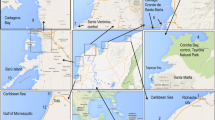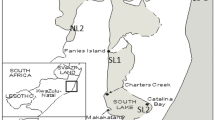Abstract
The Old Lead Belt of Missouri was a major lead-producing region for over a century. Several large tailings piles and other industrial wastes remain behind, though mining operations in the region ceased in 1972. Samples of stream sediments and fish were collected from established sites on the Big River and Flat River Creek over a 3-year period from 1998 to 2000 to evaluate ongoing remediation efforts and determine the current impact of residual mining wastes. Benthic sediments and fish taken in the vicinity of inactive industrial sites were found to contain elevated concentrations of Pb, Zn, Cu, and Cd. Concentrations of Pb and Zn in fillets of suckers and sunfish, as well as in whole bodies of sunfish, correlate well with metal concentrations observed in surficial sediments. The results of analyses provide valuable quantitative information regarding specific sources, current levels of contamination, potential risk to public health, and will allow more accurate assessment of continuing remediation efforts.
Similar content being viewed by others
References cited
Agency for Toxic Substances and Disease Registry. 1999 ATSDR-ToxFAQs-Zinc. http://atsdr1.atsdr.cdc.gov:8080/tfacts60.html
Agency for Toxic Substances and Disease Registry. 2002 http://www.atsdr.cdc.gov/toxprofiles
Blevins RD, Pancorbo OC. 1986 Metal concentrations in muscle of fish from aquatic systems in East Tennessee, USA.Water Air Soil Pollut 29, 361–371.
Bradley RW, Morris JR. 1986 Heavy metals in fish from a series of metal contaminated lakes near Sudbury, Ontario. Water Air Soil Pollut 27, 341.
Campbell KR. 1994 Concentrations of heavy metals associated with urban runoff in fish living in stormwater treatment ponds. Arch Environ Contamin Toxicol 27, 352–356.
Eisenberg M, Topping JJ. 1986 Trace metal residues in finfish from Maryland waters, 1978-1979. J Environ Sci Health 21, 87–102.
Elinder CG. 1985 Cadmium: uses, occurrence and intake. In Friberg L, Elinder CG, Kjellstrom T, et al., eds. Cadmium and Health: A Toxicological and Epidemiological Appraisal. Exposure, Dose, and Metabolism. Effects and Response, Vol. I. Boca Raton, FL: CRC Press, pp. 23–64.
Fitchko J, Hutchinson TC. 1975 A comparative study of heavy metal concentrations in river mouth sediments around the Great Lakes. J Great Lakes Res 1, 46–78.
Gale NL, Wixson BG, McMenus MW. 1982 Lead concentrations in edible fish filets collected from Missouri's Old Lead Belt. In Hemphill DD, ed. Trace Substances in Environmental Health-XVI. Columbia, MO: University of Missouri-Columbia, pp. 12–21.
Gale NL, Haas MJ, Wixson BG, Hinderberger Jr EJ. 1986 Historical trends for lead in fish, clams and sediments in the Big River of southeastern Missouri. In Hemphill DD, ed. Trace Substances in Environmental Health-XX. Columbia, MO: University of Missouri-Columbia, pp. 479–490.
Gale NL, Adams CD, Wixson BG, Loftin KA, Huang Y. 2002 Lead concentrations in fish and river sediments in the Old Lead Belt of Missouri. Environ Sci Technol 36, 4262–4268.
Gartrell MJ, Craun JC, Podrebarac DS, Gunderson EL. 1986 Pesticides, selected elements, and other chemicals in adult total diet samples, October 1980-March 1982. J Assoc Off Anal Chem 68, 146–161.
Gibbs RJ. 1994 Metals in the sediments along the Hudson River estuary. Environ Int 20(4), 507–516.
Harrison FLM, Bishop DJ. 1984 A review of the impact of copper released into freshwater environments. Prepared for Division of Health, Siting and Waste Management, Office of Nuclear Regulatory Research, U.S. Nuclear Regulatory Commission. Washington, DC.
Harrison SE, Klaverkamp JF. 1990 Metal contamination in liver and muscle of northern pike (Esox lucius) and white sucker (Catostomus commersoni) and in sediments from lakes near the smelter at Flin Flon, Manitoba. Environ Toxicol Chem 9, 941–956.
IARC. 1993 International Agency for Research on Cancer: cadmium and certain cadmium compounds. In: IARC Monographs on the Evaluation of the Carcinogenic Risk of Chemicals to Man. Beryllium, Cadmium, Mercury and Exposures in the Glass Manufacturing Industry. IARC Monographs, Vol. 58. Lyon, France: World Health Organization, pp. 119–146, 210-236.
Johnson A, Norton D, Yake B, et al. 1990 Transboundary metal pollution of the Columbia River (Franklin D. Roosevelt Lake). Bull Environ Contamin Toxicol 45: 703–710.
Kabata-Pendias A, Pendias H. 1984 Trace Elements in Soils and Plants. Boca Raton, FL: CRC Press, Inc., 315 p.
Larsen PF, Zdanowicz V, Johnson AC. 1983 Trace metal distribution in the surficial sediments of Penobscot Bay, Maine. Bull Environ Contamin Toxicol 31, 566–573.
Lowe TP, May TW, Brumbaugh WG. 1985 National contaminant biomonitoring program: concentration of seven elements in freshwater fish, 1978-1981. Arch Environ Contamin Toxicol 14, 363–388.
Mayer T, Manning PG. 1990 Inorganic contaminants in suspended solids from Hamilton Harbour. J Great Lakes Res 16: 299–318.
National Research Council. 1999 Cited in: HealthLink Online Resources: Copper. Recommendations: Suggested Intake. http:// www.healthlink.com.au / nat_lib / htm-data /htm-supp/sukpps55.htm.
Renwick WH, Edenborn HM. 1983 Metal and bacterial contamination in New Jersey estuarine sediments. Environ Pollut 5, 175–185.
Schmitt CJ, Brumbaugh WG. 1990National contaminant biomonitoring program: concentrations of arsenic, cadmium, copper, lead, mercury, selenium, and zinc in U.S. freshwater fish, 1976-1984. Arch Environ Contamin Toxicol 19, 731–747.
Sileo L, Beyer WN. 1985 Heavy metals in white-tailed deer living near a zinc smelter in Pennsylvania. J Wildlife Dis 21, 289–296.
Sprague JB. 1986 Toxicity and Tissue Concentrations of Lead, Zinc, and Cadmium for Marine Molluscs and Crustaceans. Research Triangle Park, NC: International Lead Zinc Research Organization, Inc., 215 p.
Sprenger MD, McIntosh AW, Hoenig S. 1988 Concentrations of trace elements in yellow perch (Perca flavescens) from six acidic lakes. Water Air Soil Pollut 37, 375–388.
Thornton I. 1992 Sources and Pathways of Cadmium in the Environment, Vol. 118 International Agency for Research on Cancer, Scientific Publications, 149–162.
U.S. Environmental Protection Agency. 1980 STORET. Washington, DC: Monitoring and Data Support Division, U.S. Environmental Protection Agency.
U.S. Environmental Protection Agency. 1982 An Exposure and Risk Assessment for Lead. Washington, DC: U.S. Environmental Protection Agency, Office of Water Regulations and Standards, Monitoring and Data Support Division. EPA 440/4-85/010, NTIS PB85-220606.
U.S. Environmental Protection Agency. 1986 Air Quality Criteria for Lead. Research Triangle Park, NC: U.S. Environmental Protection Agency, Office of Research and Development, Office of Health and Environmental Assessment, Environmental Criteria and Assessment Office. EPA 600/8-83-028F.
U.S. Environmental Protection Agency. 1991 Methods for the Determination of Metals in Environmental Samples. Cincinnati, OH: U.S. Environmental Protection Agency, Environmental Monitoring System Laboratory, Office of Research and Development.
EPA 600-4-91-010. (NTIS: PB91-231498) U.S. Food and Drug Administration, Center for Food Safety and Applied Nutrition. 1993 Guidance Document for Cadmium in Shellfish. http://vm.cfsan.fda.gov/-frf/guid-cd.html.
U.S. Environmental Protection Agency. 1997 The Incidence and Severity of Sediment Contamination in Surface Waters of the United States. EPA 823-R-97-006, September, 1997.
United Kingdom Lead in Food Regulations. 1979 Food and Drugs Act, 1955. London: HMSO.
Vos G, Lammers H, Kan CA. 1990 Cadmium and lead in muscle tissue and organs of broilers, turkeys and spent hens and in mechanically deboned poultry meat. Food Addit Contamin 7, 83–92.
Whitton BA, Gale NL, Wixson BG. 1981 Chemistry and plant ecology of zinc-rich wastes dominated by blue-green algae. Hydrobiologia 83, 331–341.
Wixson BG, Elliott LE, Gale NL. 1982 Influence of tailings from the Old Lead Belt of Missouri on sediments of the Big River. In Hemphill DD, ed. Trace Substances in Environmental Health-XVI. Columbia, MO: University of Missouri-Columbia, p. 3–11.
World Health Organization. 1972 Evaluation of mercury, lead, cadmium, and the food additives Amaranth, Diethylpyrocarbonate, and Octyl Gallate. 16th Report by Joint FAO/WHO Expert Committee on Food Additives. WHO Technical Report Service No. 505.
Author information
Authors and Affiliations
Rights and permissions
About this article
Cite this article
Gale, N.L., Adams, C.D., Wixson, B.G. et al. Lead, Zinc, Copper, and Cadmium in Fish and Sediments from the Big River and Flat River Creek of Missouri's Old Lead Belt. Environmental Geochemistry and Health 26, 37–49 (2004). https://doi.org/10.1023/B:EGAH.0000020935.89794.57
Issue Date:
DOI: https://doi.org/10.1023/B:EGAH.0000020935.89794.57




